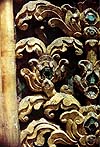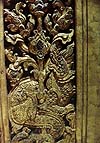 |
| 
Introduction by Willard Van De Bogart
The Ayutthaya period carvings that have survived are well over 300 years old. As shown in the temple door at Wat Yai Suwannaram there is severe deterioration as a result of age and weathering. Chemical preservatives many times ruin the natural look of the original carvings as shown by the application to the wood on the upper temple carvings at Wat Yai Suwannaram. The legacy of these carvings not only comes from Thailand's history, but also from the ancient Khmer civilization which created Angkor Wat in the 12th century. When Thailand invaded Angkor Wat in 1431AD it took with them many of the artisans from that culture. All of the wooden temples in the classic Khmer period no longer exist. If Thailand does not pay more attention to its National Treasures it too will loose these magnificent works of art.
The two photographs below show a completely weathered door from the Ayutthaya period that is currently being protected inside Wat Rakang, however, no kind of wood protection has been applied to it, and it will continue to deteriorate. The more recent carving to the right is the door currently at the Ayutthaya temple erected in Wat Rakang, and there are clear signs of the gold leaf being eroded as well as the wood.
 |
| 
 |
|  |
| 
Photographs by Willard Van De Bogart
These photographs clearly show signs of weathering. The concerns expressed in The Nation newspaper are very timely. The message is clear. Thailand must manage it's national treasures in such a way that they will be preserved for many years to come so all the world can appreciate their beauty.
Editorial Sunday May 2, 2004 - The Nation, Bangkok
Thailand's focus on marketing itself as a major international tourist destination may have generated more tourists dollars, but the Kingdom lags behind other countries in the Asia Pacific region when it comes to the upkeep and management of its sites of historical and cultural significance. According to Unesco's World Heritage list, Thiland boasts only four World Heritage sites:
Surely Thailand would not have become a tourism hub of Southeast Asia unless it had much to offer. The World Heritage tag is an acknowledgement of the outstanding value of historical and cultural sites. The new sites added last year to Unesco's list include the three parallel rivers of the Yunnqn protected areas in China and Ke Bang National Park in Vietnam.
As any thourist brochure will tell you, Thailand has no shortage of pristine nature, culture or history. The Kingdom boasts 55 national parks in the North, 24 in the Northeast, 15 in the Central Plains, and 20 in the South, plus 24 marine national parks. But how do these places stand from the point of view of science, natural beauty and conservation?
You hardly see any of the crocodiles that once abounded in the caves in Tarutao National Park. They have been replaced by mosquitoes. The encroachment of urban development has reached the fringes of national aprks in Koh Chang. Elswhere, wild-elephant numbers have dwindled as farmers continue to tresspass on their natural habitat.
As for sites of historical significance, the ugly scourge of weekend markets springing up around old religious structures does not seem to bother any of the relevant authorities, including the Fine Arts Department and the Tourism Authority of Thailand. One of the worst examples is centuries-old Wat Phrasrirattana Mahathat on the bank of the Yom River, outside the walls of the historical city of Srisatchanalai in Sukhothai (which is home to another World Heritage site), where monks make money by allowing vendors to run a weekend market on the monastic grounds.
The tourist invasion disrupts the tranquillity that enhances the dignity of popular historical places like this one. Meanwhile, there are many other sites that are in need of better managemnt and urgent restoration work, which will require more advanc ed efforts than simply collecting entry fees from tourists.
The issue is that running such sites requires a high degree of knowledge of cultural management. This kind of knowledge will ultimately make it possible to maintain a reasonable balance between the number of cultural and natural heritage properties and the natural integrity of the surronding environment.
Having more World Heritage sites means also having higher tourism-management standards. Despite its plethora of scenic and historical attractions, Thailand has not successfully nominated many sites to receive World Heritage status. This is a reflection of the country's poor management standards. The matter is something that concerned parties in both the private and public sectors need to seriously consider.
Though it may be true that Thailand will continue to look like a tourist paradise for some years to come, the authorities cannot simply continue to market the Kingdom's heritage without actually putting any money where its mouth is by promoting high standards in the mangement of it's historical, cultural and natural monuments.
By the time degradation of these attractions becomes obvious, it may already be too late to reverse the damage.